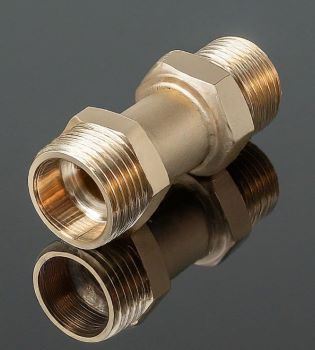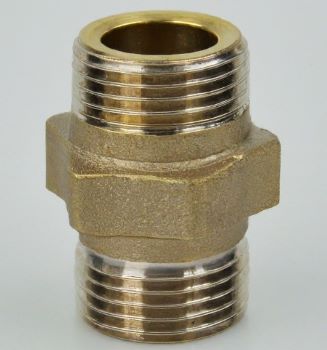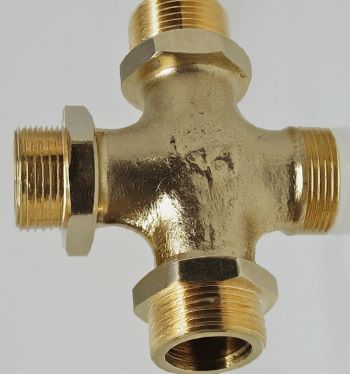Bulkhead plumbing fittings may not be the center of attention, but they play a crucial role in any functional plumbing system. These versatile parts create secure passageways. They are for water lines through walls, floors, and other barriers.
Whether you’re a DIY enthusiast or a homeowner tackling a plumbing project, you need to understand these fittings. They are crucial for a successful, leak-free installation.
Types of Bulkhead Plumbing Fittings
There are several types of bulkhead fittings, each categorized by its connection method:
➡️ Threaded Bulkhead Fittings:
These workhorses feature threads on both sides for screwing directly onto pipes. They are commonly made from durable brass or stainless steel. They’re ideal for high pressure or hot water, like connecting washing machine supply lines.
Pros: Strong, secure connection, easy to install and disassemble.
Cons: Requires proper threading technique to prevent leaks, limited to threaded pipe systems.
➡️ Compression Bulkhead Fittings:
These fittings utilize a compression ring to create a watertight seal around the inserted pipe. They are often made from brass or plastic. They’re a good choice for softer PEX tubing or for situations where soldering isn’t possible. For example, connecting ice maker water lines.
Pros: Versatile, easy to install without special tools, suitable for various pipe materials.
Cons: Not ideal for high-pressure applications, plastic versions may degrade over time.
➡️ Flanged Bulkhead Fittings:
These fittings boast a flange on one side for bolting securely onto a flat surface. They are typically made from cast iron or PVC. They are good for high-pressure or large pipes. These pipes are used in industry or for mounting pumps and filters.
Pros: Strong, leak-proof connection for high-pressure or large-diameter pipes.
Cons: Bulkier design, requires additional space for bolting, installation can be more complex.
Choosing the Right Bulkhead Fitting
Selecting the best bulkhead fitting requires considering several factors:
✅ Material Compatibility: Ensure the fitting material matches your existing pipe system (e.g., brass for copper pipes, PEX for PEX tubing).
✅ Size: The fitting size should perfectly match the diameter of your pipes for a secure connection.
✅ Pressure Rating: Choose a fitting with a pressure rating exceeding your water system’s pressure to avoid leaks or bursts.
✅ Application: Consider the specific use case. Choose durable fittings for hot water or washing machines. Compression fittings might work for ice makers.
Applications of Bulkhead Plumbing Fittings
The versatility of bulkhead fittings extends across various plumbing systems:
➡️ Interior Plumbing:
These fittings provide hidden access points. They are for connecting pipes behind sinks, toilets, and dishwashers. They are also for running water lines within walls. They offer a clean aesthetic by minimizing exposed pipes.
➡️ Exterior Plumbing:
Bulkhead fittings are used for hose bibs on exterior walls, allowing for easy attachment of garden hoses. They also play a role in sprinkler systems, creating water supply points underground.
➡️ Marine Applications:
Boats use bulkhead fittings for water intake and discharge. They ensure safe passage through the hull and keep it watertight.
➡️ Industrial Applications:
Bulkhead fittings connect pipes to tanks, pumps, and other equipment. They enable controlled water flow in process piping within industrial settings.
Installation Tips for Bulkhead Fittings
Installing a bulkhead fitting has these steps. Remember to consult a professional for complex plumbing jobs.
➢ Safety First: Turn off the water supply and relieve any pressure in the line. Utilize proper tools and wear safety glasses.
➢ Measure and Mark: Carefully measure and mark the precise location for the fitting on the bulkhead (wall, floor, etc.).
➢ Drilling: Using the appropriate drill bit size, drill a clean hole through the bulkhead to accommodate the fitting.
➢ Attach the Fitting: Depending on the type (threaded, compression, flanged), follow the specific instructions to secure the fitting to the bulkhead with proper sealing materials like plumber’s tape.
➢ Connect the Pipes: Attach the pipes to the fitting using the appropriate method (threading, compression, or bolting).
➢ Turn on the Water and Check for Leaks: Gradually turn on the water supply and meticulously inspect all connections for leaks. Tighten any loose parts if necessary.
Considerations for Different Pipe Materials: While the general steps apply, some adjustments might be needed for specific pipe materials. For example, PEX tubing with compression fittings might require a special insertion tool. Always consult the manufacturer’s instructions for the best installation practices.
Conclusion
You can tackle various plumbing projects with confidence. How? By understanding the types, uses, and installation of bulkhead plumbing fittings. These parts are versatile and ensure smooth flow. They keep your water system working perfectly.
Remember, for complex installations, consulting a licensed plumber is always recommended. If you want to explore different fitting options, go to your local plumbing supply store or shop online. With the right knowledge and tools, bulkhead plumbing fittings can be your allies. They help in making a watertight and efficient plumbing system.
Post time: Apr-29-2024




